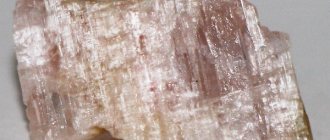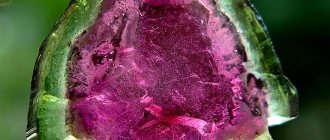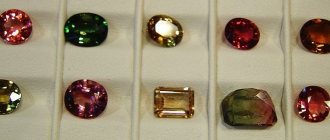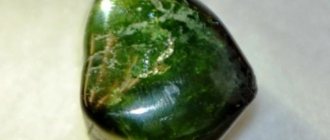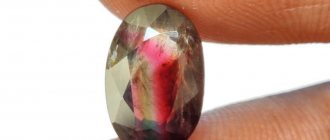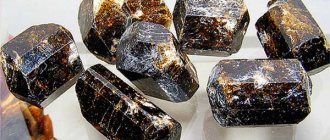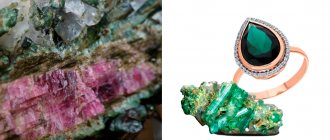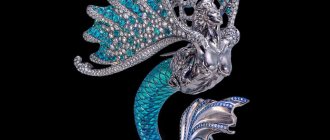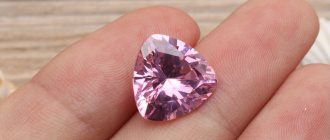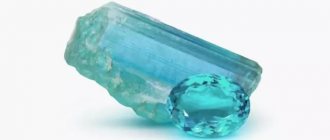/ List of stones / Properties of Pink Tourmaline
0
5933
Article rating
Rubellite or pink tourmaline is the stone of Venus and Cleopatra, which was first described by the Irish scientist Richard Kirwan in the second half of the eighteenth century. The name of the mineral comes from the Latin rubellus, which means reddish. This stone is otherwise called crimson schorl, apirite, daurite, sibirite. A separate variety of rubellite is elbaite, mined on the island of Elba and distinguished by its particular beauty.
Pink tourmaline
Shades of pink tourmaline can range from deep red to soft pink. In total, there are more than fifty color varieties of this mineral. The color saturation depends on the amount of manganese compounds in the stone. In appearance, rubellite is sometimes confused with rubies. Under this name it even found its way into imperial crowns. In fact, these two stones are easy to distinguish: in the light, a ray passing through a ruby will be red, and through a rubellite it will split into two different shades. Transparent stones are classified as precious stones. Opaque - are considered ornamental and are used in interior design, making small figurines and costume jewelry.
History and origin
Tourmalines are a large family of gems that vary in color but have similar properties.
By nature, these are aluminum borosilicates with a very complex formula. The composition of rubellite additionally includes sodium and divalent manganese, which provides reddish-pink shades. Other colors of tourmalines contain iron, lithium, potassium, calcium, chromium, magnesium and fluorine.
Pink tourmaline gemstone
Pink tourmaline had an unusual fate. It became known in Europe and Russia around the end of the 14th century, reaching the West in a roundabout way from Asia. They knew about tourmaline in ancient Greece and Rome, but they could not distinguish it from other stones of similar color - rubellite from ruby, verdelite from emerald, indigolite from sapphire. Even many rubies in the personal jewelry and crowns of the kings of the Czech Republic and the kings of Rus', after testing in the 18th–19th centuries, when science had reached a sufficient level, turned out to be tourmalines.
Among the treasures of the Russian Empress Catherine the Great is a magnificent 255-carat bunch of grapes carved from a red gem.
The Swedish king Gustav III, who gave her this bunch, claimed that it was made of ruby and in ancient times belonged to Julius Caesar himself. In fact, it is made of rubellite.
The study of tourmalines as independent stones began in 1704, when the Dutch brought pink and bicolor red-green crystals from their colony, the island of Ceylon, which were called “turmalli” in Sinhalese (one of the Ceylonese languages). This literally means “precious stone”.
Pink tourmaline pendant
For 90 years, the stone was studied by various scientists, and in 1794, the Irishman Richard Kirwan finally established that it was a completely independent mineral. He also described the physical properties of the stone.
Now rubellite belongs to the second order of the first group of precious stones of jewelry value (according to the Fersman-Bauer classification). It is valued on the same level as noble opal, topaz, aquamarine, uvarovite and zircon and is only slightly inferior in price to sapphire, ruby and emerald. A gold piece with a red or pink tourmaline crystal, depending on the weight of the stone and the gold, can cost several thousand dollars.
Opaque tourmaline is used as an ornamental stone. In Rus', raspberry sherl, like any other pink stone, was called lal or lalik.
Rubellite stone is used not only in the jewelry industry. It is used in radio engineering and some contact healing products of alternative medicine, such as health lumbar belts, knee pads and mattresses, since it is believed that these stones are capable of ionizing the air.
Talismans and amulets
Ring with polychrome tourmaline
Tourmaline has a wide range of uses as a talisman. They believed in its power from ancient times, even the ancient Romans, Egyptians and other peoples.
The Indians called tourmaline a male gem. According to their beliefs, the stone adds masculinity and assertiveness to the stronger sex, and also increases potency.
Blue varieties of tourmaline are necessary for clergy, as well as judges and other law enforcement officials, since the stone does not tolerate liars and hypocrites. He always strives to bring them to clean water. Priests will be able to assess the sincerity of the penitent, and judges will be able to establish the truth.
Traditionally, as it is relevant for many gems, tourmaline helps creative individuals to reveal their abilities and convey them to humanity, while receiving recognition.
The pebble is also useful for those who spend a lot of time at the computer or TV. It neutralizes harmful radiation from these devices.
Pink varieties are a feminine assistant in the fight against uncertainty, indecision and weakness of spirit. With them, women will become stronger morally, as well as more attractive and energetic.
Regarding the varieties of tourmaline, psychics and magicians give recommendations for wearing them by day of the week, explaining that on these days a stone of a certain color is most effective. On Sunday you need to wear rubellite (pink), on Saturday and Monday - verdelite (green), on Friday and Thursday - indigolite (blue), on Wednesday - scherl (black), on Tuesday - red specimens.
Blue crystals are useful for married couples, especially newlyweds, for building strong relationships and mutual trust, as well as for rekindling faded feelings.
Blue varieties help scientists and researchers by opening their eyes wider, sharpening their gaze, helping them see what is important among the trash, form a big picture and draw the right conclusions.
Physicochemical characteristics
The physicochemical characteristics of this stone are unique. It has a hardness of up to 7.5 Mohs, a fairly high density, but is also fragile. The degree of transparency varies; Rubellite stone can be transparent or opaque.
Polychrome specimens of tourmaline are quite common.
Part of the stone is painted green, part - pink. Specimens with a red center and green edges are mined, or vice versa - with a green center and a red-pink perimeter.
Transparent pink tourmaline has the same properties as its other counterparts:
- pleochroism - the ability to change color from pink to yellowish depending on the lighting;
- birefringence - a ray passing through a crystal is split into two;
- slight dispersion.
But pink tourmaline, unlike red, does not have luminescence. That is, it does not glow in the dark.
This gem has the ability to become electrified by friction, heat or pressure, with one end of the crystal accumulating a positive charge and the other a negative one.
| Formula | height 2 cm Formula Na(Li,Al)3Al6[(OH)4|(BO3)3Si6O18] |
| Color | Pink |
| Shine | Glass |
| Transparency | Transparent to opaque |
| Hardness | 7—7,5 |
| Cleavage | Unclear |
| Kink | Uneven, small-shelled; fragile |
| Density | 3.02—3.26 g/cm³ |
Colors and varieties
There are many varieties of tourmaline. They are distinguished by color, place of extraction, properties and other criteria.
Paraiba
Stunningly beautiful tourmaline in blue, emerald green and crimson colors. It is mined in the state of the same name in Brazil. The stone is valued for its transparency, quality and rich color, and therefore has a high price.
Paraiba Tourmaline
Watermelon tourmaline
It got its name for its visual resemblance to a watermelon slice - the edges are green, the middle is red interspersed with white and black.
Watermelon tourmaline
Sherl – black tourmaline
The black color of the mineral comes from a large amount of iron impurities. This variety is not valued too highly and is rarely used for insertion into jewelry, but it is very popular among all kinds of mystics.
Sherl – black tourmaline
Rubellite – red-pink tourmaline
Rubellites include specimens of all shades of red - from light pink to raspberry and cherry. The highest quality stones are rich scarlet and burgundy in color and are very similar to rubies.
Rubellite – red-pink tourmaline
Chameleonite
An interesting variety that changes color in different lighting conditions. For example, under the sun's rays the stone appears green, but under electric lamps it appears red. This feature causes a rather high cost.
Tourmaline chameleonite
Indigolite – blue tourmaline
All specimens of blue color are considered to be of this variety; dark blue stones are considered especially valuable.
Indigolite – blue tourmaline
Verdelite - dark green tourmaline
This variety has a dark green color.
Verdelite - dark green tourmaline
Chrome tourmaline (green)
Due to the high content of chromium in the composition, the stones have a rich green color, often similar to emeralds, for which they are especially revered by jewelers.
Chrome tourmaline
Achroite - colorless tourmaline
A transparent gem, which is also called “elboite” due to the fact that it was most often found on the Elbe River in Germany.
Tourmaline achroite colorless
Dravite – brown-yellow tourmaline
This variety includes brown, yellowish and golden specimens.
Brown-yellow tourmaline – Dravite
Burmese (scratched) tourmaline
This variety ranges in color from garnet to dark purple. Its peculiarity is its internal structure. On the outside, the surface of the stone is perfectly smooth, but on the inside, stripes are visible, as if the stone was scratched.
Burmese tourmaline
Sibirit – crimson tourmaline
The Russian variation of rubellite has a crimson or reddish-violet hue.
Tourmaline Sibirit
Polychrome tourmaline
Polychrome stones include stones that combine several color zones. They are considered rare and are highly valued.
Polychrome tourmaline
Mining locations
Tourmaline deposits are located in different regions of the globe. The pink variety is mined on the island of Elba (these stones are called elbaites), in Sri Lanka (formerly Ceylon), in Brazil - the states of Bahia and Minas Gerais, in the USA - the state of California. In Russia, it is found in Transbaikalia (Malkhan deposit) and on the Kola Peninsula, in the Voronya tundra area.
Pink tourmaline beads
But in our country, deposits of pure pink tourmaline are rare; it is mostly found together with green.
Rubellite often accompanies zircon, corundum, hematite and spinel in rocks.
Historical reference
Tourmaline was known to the healers of Ancient Rome, Byzantium and Rus' (XIV century). Three hundred years later, Europe became acquainted with the stone. The history of the appearance of the gem on the continent is connected with Dutch sailors.
The name of the stone comes from the Sinhalese word "turamali" or "toramalli" which is applied to various precious minerals in Sri Lanka. Until the 14th century, red varieties of tourmaline were in circulation under the general name “lal”.
The term "turmali" in the local dialect means "stone that attracts ash" or "magical multi-colored stone."
The legendary gem in the form of a bunch of grapes is the “Caesar's Ruby”. According to legend, Cleopatra gave it to Caesar. Then traces of the stone were lost, it wandered around the countries until it came to the Swedish king in the 18th century. Gustav VIII presented it to Russian autocrat Catherine II.
Catherine's bunch of grapes
From the day it appeared, the “bunch of grapes” was considered ruby. Only in the 20th century did they find out that this is Burmese pink tourmaline. The jewel is the property of the Diamond Fund of Russia. Another famous Russian artifact is the 500-carat stone in Anna Ioannovna’s crown.
Medicinal properties
The healing and magical properties of tourmaline depend on its color.
Lithotherapists, together with esotericists, believe that pink tourmaline affects the heart and sacral chakras. Its “area of responsibility” includes the heart, along with the entire cardiovascular system, the terminal part of the intestine, as well as the thoracic, sacral and coccygeal sections of the spine.
Jewelry with pink tourmaline is useful to wear for people suffering from cardiovascular diseases - hypo- or hypertension, coronary disease, including those who have had a heart attack.
The precious gem promotes active saturation of the blood with oxygen, which improves the general condition of the body and stimulates thought processes. It is suitable for those who suffer from problems with the musculoskeletal system, pain in the thoracic and sacral spine, for example, with hernias. For this purpose, there are special mattresses and corsets in which tourmaline crystals are arranged in an optimal manner for treatment.
Rubellite treats diseases of the rectum, such as hemorrhoids, as well as prostatitis in men.
Emotionally, pink tourmaline has a liberating effect.
It relieves a person from unnecessary complexes and embarrassment, helps to openly express his feelings, including in the intimate sphere.
Ring with pink tourmaline
This stone has projective yang energy, that is, it is a specific “male” mineral.
For representatives of the fair sex, tourmaline will add sexuality and self-confidence, but they should wear it with caution - it can lead natural passion to nymphomania and sexual intemperance.
This stone “loves” naturally strong natures, emotional and bright, but at the same time strong-willed and self-confident. But it is better for the lazy and weak-willed to avoid it - rubellite will give them a thirst for activity, but will not be able to overcome their natural laziness. As a result, a person can easily develop a neurotic or psychotic illness.
Earth element
Representatives of the Earth element are real careerists, for whom it is very important to succeed in the professional sphere and gain financial independence. In the first place they have financial wealth, their own comfort and stability, and a secondary position is occupied by feelings, relationships, friendship
But these zodiac signs usually hide their emotions from others and remain cold on the outside.
Capricorn
Capricorns are characterized by a tendency to prudence, pedantry and excessive severity. It is very difficult for such strict and cold personalities to open up, surrender to feelings and truly fall in love.
It is very important for Capricorn to feel the warmth and love of their chosen one; they can spend their entire lives in search of “that very ideal.” It is the love of everything ideal that makes it unbearable for them to have to come to terms with the shortcomings of others and themselves.
An amulet stone can make stubborn people softer, more patient and open.
Taurus
For a Taurus woman by date of birth, it is very important to feel calm and stability; her patience can often run out if outsiders try to get into her soul, violating boundaries. Tourmaline is necessary for Taurus, as it will allow a hot-tempered nature to better control their emotions, not succumb to anger and malice, and remain cautious and reasonable in difficult life moments.
Virgo
Virgos often demonstrate coldness towards others; they are closed and withdrawn, and like to be alone with themselves. Relationships with the opposite sex do not matter to them.
Virgos believe that mental suffering or causeless fun are nonsense, and ordinary joys (receiving gifts, going to a cafe, taking care of themselves) are a waste of time. For such closed natures, such a gem will allow them to open up, learn to enjoy life, appreciate pleasant moments and devote more time to themselves.
Magic properties
The magical properties of pink tourmaline lie in its ability to give inspiration and creative strength to artists, sculptors, musicians and writers - in a word, any creative people.
At the right moment, it gives them confidence and courage, and also attracts monetary luck, since talent needs to be nourished. At the same time, the stone attracts love, but you need to be careful here, since it casts a love spell by increasing the sexual charisma of its wearer. In some cases this may be unnecessary.
How to buy rubellite tourmaline in Moscow?
In our catalog you will always find excellent examples of red and bright pink rubellites, you will be able to compare prices and understand the approximate budget for a future purchase.
To see this jewelry stone and products with it in person, we invite you to visit our boutique in the center of Moscow.
In addition to the stones in stock, our team is happy to offer a custom order service. Based on your requirements and budget, we will select the best example of rubellite for you.
You can also order the manufacture of jewelry with this stone. Today we have one of the best full-cycle jewelry workshops in Moscow.
Zodiac compatibility
Which zodiac signs is Elbaite suitable for? First of all, these are Libra - strong-willed, quite strong, but sometimes feeling the need to feed their self-esteem from the outside.
Earrings with pink tourmaline
Since pink or red tourmaline, unlike its counterparts, is associated with Fire, the magic of the stone will help the fire signs of the zodiac - Aries, Leo, but not Sagittarius, who needs indigolite.
Representatives of Water signs, except Scorpio, should not wear rubellites.
| Zodiac sign | Compatibility |
| Aries | +++ |
| Taurus | _ |
| Twins | + |
| Cancer | + |
| a lion | +++ |
| Virgo | _ |
| Scales | + |
| Scorpion | +++ |
| Sagittarius | — |
| Capricorn | _ |
| Aquarius | + |
| Fish | _ |
(“+++” – fits perfectly, “+” – can be worn, “-” – is strictly contraindicated)
Interaction of rubellite with zodiac signs
Pink tourmaline is primarily suitable for people born under the sign of Libra. He helps women find their betrothed, create a peaceful and warm environment in the house, preserve love and family hearth. Any jewelry with rubellites can serve as amulets for them. But for men there is a very specific amulet. If a man born under the sign of Libra constantly wears a ring with red tourmaline, he will become more courageous, self-confident, cool-headed and get rid of indecision.
Astrologers note that wearing pink tourmaline is not contraindicated for any of the zodiac signs. This peaceful stone is “friends” with almost every one of them. It is especially good to use this stone to increase vitality for Aries and Leos. This is this magical stone that protects love and soothes the soul, healing and supporting.
Compatibility with other stones
The meaning of the stone in this regard is Fire, but due to some properties it is not compatible with the fire garnet - except for its green subspecies.
Earrings with pink tourmaline and ruby
Rubellite goes well with:
- with ruby;
- diamond;
- coral;
- heliodor;
- grossular;
- amber;
- spinel.
Its properties will be enhanced by the company of the Air mineral - green demantoid and uvarovite garnets, various quartz - from rock crystal to amethyst, other types of tourmaline, except blue indigolite, as well as chrysolite and chrysoprase.
A combination with Earth - any opaque stones, primarily malachite, azurite, chrysocolla, turquoise and jasper - will be neutral, not good, but not bad either.
Gold ring with pink tourmaline and malachite
It is unacceptable to wear pink tourmaline simultaneously with Water stones, as well as minerals of the “double element” - Water and Earth, Water and Air.
Among them:
- emerald;
- sapphire;
- alexandrite;
- indigolite;
- aventurine;
- zircon;
- melanitis.
Description and external signs
Rubellite is a representative of natural minerals, one of the varieties of tourmaline boroaluminosilicate with a unique color scheme. Thanks to the admixture of divalent manganese, this mineral has such rich pinkish hues. What does this gem look like? Rubellite crystals have a glassy luster, matte or transparent structure, can be transparent or translucent, with a white streak color. In nature, there are specimens of pink, dark pink, crimson, cherry, violet-red, red, and dark red shades.
Rubellite is part of the elbaite group with pink and crimson colors. If transparent crystals are found, then they are representatives of class 2 gemstones. This mineral is associated with kunzite, quartz, lepidolite, aluminum and lithium silicate of lilac color. Outwardly, it is similar to a ruby. The place of its formation is pegmatites. This natural stone is also popularly called apirite, siberite, red tourmaline, daurite, and raspberry schorl.
Application area
Pink tourmaline is used in the jewelry industry to make jewelry.
It is used to make earrings, beads, rings, rings, and less commonly, tiaras and necklaces. There are different types of cuts - from cabochon to diamond. The greatest demand is for specimens weighing 2 carats and above, but only defect-free stones are valued.
Elbaites are set in white and yellow gold, as well as in silver.
Gold pendant with tourmaline
Mineral deposits
California, Madagascar, Ceylon, Namibia and Mozambique are famous for the largest deposits of “pink tourmaline”, while the largest crystals up to 40 cm in length are mined in Brazil.
Eastern Transbaikalia and the Middle Urals of Russia are rich in rubellite deposits. Rubellites mined in the Ural deposits have found their application in jewelry. Large pieces of rock are quite suitable for making decorative items such as vases, figurines and boxes.
There are several deposits in Kazakhstan where good quality rubellites are found in deposits of rare earth pegmatites.
In Europe, jewelry stones are mined in Germany, Italy and the Czech Republic.
How to spot a fake
Tourmalines are often counterfeited by making imitations from glass or less valuable minerals.
There is a technique of “ennobling” - high-temperature treatment, during which the stone changes color. Thus, pink tourmaline can be obtained from less valuable red-brown.
If the price tag says “refined,” the price of the stone should be lower. If it says “natural rubellite”, then if it is annealed it is a fake.
It is impossible to independently check whether the stone was annealed or not. This is done only in a gemological laboratory. But you can distinguish it from glass or other mineral. Heat the stone with a lighter and hold it near small pieces of paper or sawdust - if the stone is real, they will move. This occurs due to the phenomenon of pyroelectrification.
Conditions for the formation and location of tourmaline
The origin is endogenous, high-temperature, pegmatite, metamorphic, hydrothermal-metasomatic.
Polychrome tourmaline crystal, height 2 cm
Most tourmaline deposits are associated with acidic igneous rocks and are common in many granites and granitoids, where they are formed in the last stage of cooling of intrusions. Characteristic of various granite pegmatites (scherl, indigolite, polychrome tourmalines). They are found in pneumatolithic-hydrothermal deposits, in feldspathic-quartz, tourmaline-quartz veins together with cassiterite, wolframite, beryl, and topaz.
Found in greisen (elbaite), in high-temperature hydrothermal sulfide-quartz veins and in zones of near-vein alteration of host rocks.
It is found in small quantities in contact-metamorphic rocks associated with acidic granites, in skarns, and hornfels.
The mineral is resistant to physical weathering and transport and redeposition and therefore accumulates in placers in association with hematite, corundum, zircon, and spinels in quartz sediments.
How to wear and care
For the magical properties of the stone to work, it is worn either in a gold pendant around the neck, or in a gold or silver ring - on the index finger of the right or middle finger of the left hand.
Silver ring with pink tourmaline
Due to its fragility, it must be protected from mechanical stress.
Store in a separate section of the stone box and wash with a mild soap solution.
From time to time the stone needs to be cleansed of accumulated negative energy and recharged. To do this, first immerse it in water for 2-3 hours, where the silver product will be located at the same time, and then put it in the sunlight to dry.
What minerals does it combine with?
It is strictly forbidden to combine tourmaline with:
- rubies;
- topaz;
- emeralds;
- grenades;
- malachite;
- diamonds.
Despite the fact that the element of tourmaline is Air, it is well complemented by the water stone opal. Tourmaline goes well with the solar mineral - carnelian. Despite their similarity, these stones never interfere with each other.
All other precious and semi-precious stones neutralize the beneficial properties of tourmaline, so it should be worn separately from other minerals.
Features of care and storage
Jet is a rather finicky stone. In order for it to retain its physical and magical properties for as long as possible, you need to follow some storage and care rules. Namely:
- Store the stone in a separate box or place it in a soft cloth bag that will limit contact with other items. This will help protect the jet from scratches and chips.
- Store the stone in a cool place and as far away from heat sources as possible. Elevated temperatures can cause color distortion and deformation of the stone.
- To remove dust and restore the shine of jet, it is enough to periodically wipe it with a woolen cloth. Exposing it to detergents is strictly prohibited.
